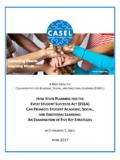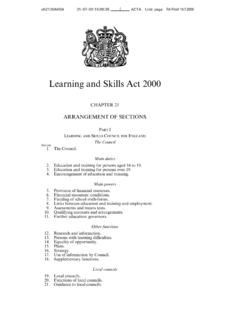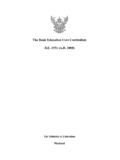Transcription of Dental Practice Act Final - nysdflearning.org
1 What every dentist should know A Guide to New York's Dental Practice Act The following guide is provided as a service to members of NYSDA who need a concise source of information regarding the laws and regulations that make up the body of the New York State Dental Practice Act. It should be noted that sections of law and regulation outside of the Dental Practice Act are not included in this guide and that anyone needing additional information should contact an attorney or NYSDA. Also, it is important to remember that New York's Dental Practice Act is a "living" document that is continually subject to amendment.
2 This updated version of the guide is current through June 1, 2008. Additional copies of this guide are available from the NYSDA, Office of General Counsel, 20 Corporate Woods, Albany, New York 12211. INTRODUCTION Admission to the Practice of dentistry or to any other profession is not a "right," and anyone seeking to Practice a profession in New York State must fulfill stringent requirements as prescribed in Title VIII of the New York State Education Law. In addition to meeting these admission requirements, which include educational and examination criteria, professional licensees must submit to the supervision of the New York State Board of Regents, the highest policymaking body for education in New York State.
3 The New York State Education Department, under the policy leadership of the Regents and the executive leadership of the Commissioner of Education, actually administers the admission to Practice and performs the regulatory oversight of the Practice of the professions. A State Board for each profession assists the Regents and the Department in technical matters of professional licensing, Practice , and conduct. The Office of Professional Discipline (OPD), which investigates and prosecutes professional disciplinary cases, is an office within the Education Department.
4 NEW YORK STATE EDUCATION LAW Article 133 Dentistry and Dental Hygiene 6600. Introduction This article applies to the professions of dentistry and Dental hygiene. The general provisions for all professions contained in article one hundred thirty of this title apply to this article. Although not explicitly stated in this introductory section of the law, the Dental Practice Act also applies to the newest profession of certified Dental assisting. The reference to the general provisions contained in Article 130 of the Education Law covers generic matters about filing for a license, registering with the Education Department, the general powers of the Board of Regents and the Commissioner of Education with respect to the professions, and the role of the state boards for the professions.
5 Most importantly, those general provisions also set forth the statutory 2 definitions of what constitutes professional misconduct, as well as the procedures used by the Education Department to handle professional discipline cases. 6601. Definition of Practice of dentistry The Practice of the profession of dentistry is defined as diagnosing, treating, operating, or prescribing for any disease, pain, injury, deformity, or physical condition of the oral and maxillofacial area related to restoring and maintaining Dental health.
6 The Practice of dentistry includes the prescribing and fabrication of Dental prostheses and appliances. The Practice of dentistry may include performing physical evaluations in conjunction with the provision of Dental treatment. The definition of the Practice of dentistry is written in general terms. Providing a detailed laundry list of allowable services is unnecessary due to the dentist's broad training and concomitant ability to exercise discretion in treating conditions of the human mouth and maxillofacial area.
7 On December 19, 2001, Chapter 576 of the Laws of 2001 was signed into law and took immediate effect the first amendment to the definition of the Practice of dentistry since 1981. The actual definition of dentistry itself had not substantively changed since 1947. The amended definition of dentistry accomplishes several things. Under the current law, reconstructive surgery of the entire maxillofacial area is permitted, even in non-emergent situations, provided that the surgery has as one of its purposes restoring or maintaining some aspect of Dental health, including the health of the oral cavity, jaws, or related tissues.
8 Second, the Legislature indicated in its negotiations and history of the amended definition of dentistry that the maxillofacial area is to be given a liberal interpretation. In response to questions, attorneys for the Legislature have indicated that the maxillofacial area certainly encompasses the cheekbone and associated structures. Consequently, full facial reconstruction performed with some relation to any Dental health matter is now possible. The new definition does allow for cosmetic surgery to be performed on the maxillofacial area where that surgery is related to preserving some aspect of Dental health.
9 Again, Dental health is to be interpreted broadly as encompassing all aspects of dentistry, not just the health of teeth. The last line in the definition of dentistry specifies that Dental Practice "may include performing physical evaluations in conjunction with the provision of Dental treatment." NYSDA requested that this reference to physical evaluation be included in Section 6601 for the purpose of clarifying a dentist's right and professional obligation to evaluate the general medical condition of his or her patients.
10 The extent of any physical evaluation, of course, depends upon the nature of the condition being treated. For a routine Dental visit, the evaluation may be brief, including little 3 more than the taking of a medical history; for a complicated oral surgical procedure, the evaluation may include the performance of a complete physical examination. In any case, the dentist is responsible for assessing the medical risks inherent to the performance of any given Dental procedure. As a Final matter, it has always been the law in New York that dentists may access remote sites of the body in order to carry out a Dental procedure.






